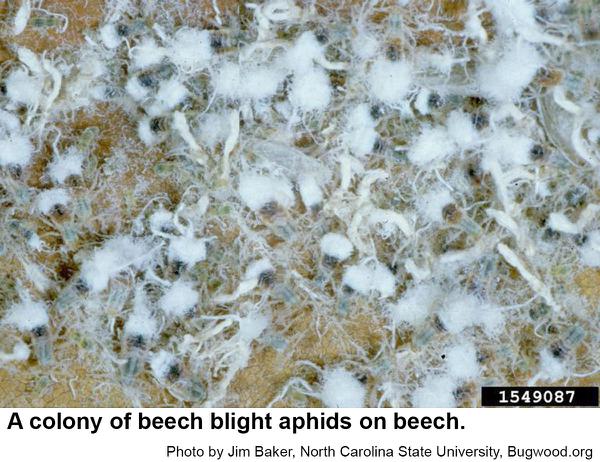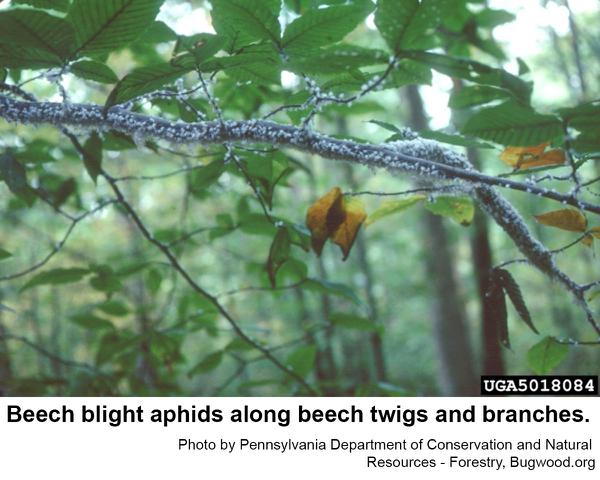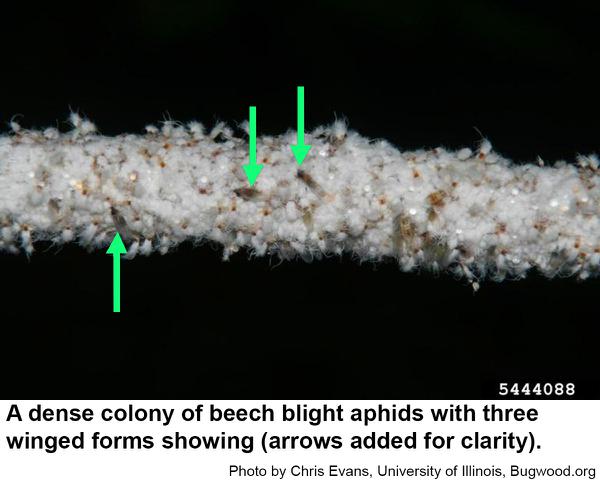Description and Biology
The beech blight aphid, Grylloprociphilus imbricator, is a small (early nymphs) to medium sized aphid (older nymphs and adults) that is bluish gray. The rear half of the abdomen may be obscured with a dense, white, fluffy secretion interspersed with long, slender, white filaments. Sometimes on beech these aphids increase to enormous numbers to the point that the mass of aphids is practically hidden by the long, white, fluffy filaments and the colony may extend up to five feet along a branch. Beech blight aphids spend the winter on the roots of bald cypress where they are little noticed. On beech, the colonies persist as white, fluffy masses from April through November in North Carolina. During that time, winged beech blight aphids leave the colony to fly to bald cypress. During the winter, aphids from the roots of bald cypress fly to beech where they lay eggs for the next spring generation. Beech blight aphids become a real nuisance because of the honeydew they excrete, the sooty molds that grow in the honeydew, and the appearance of the aphids themselves. The sooty mold associated with this aphid is Scorias spongiosa that may form a black, thick, spongy mass. The beech blight aphid sometimes becomes amazingly abundant even on forest trees. Aphid populations are sometimes devastated by Cephalosporium lecanii, a fungus that infects aphids as a sort of super athlete's foot disease. Beech blight aphids are also known as boogie-woogie aphids because when a colony is disturbed, the nymphs lift their abdomens high in the air and thrash in unison as an apparent warning to predators. Beech blight aphids are threatened by parasites and predators. However, nymphs of these amazing aphids can use their mouthparts to “sting” predators, effectively protecting the colony. Indeed, beech blight aphids may even sting an unwary observer who allows them to come into skin contact! The aphids, their grunge and sooty molds may persist for some months.
Host Plants
The beech blight aphid cycles from bald cypress (and perhaps Cryptomeria) to American beech.
Residential Recommendations
Pyrethroid insecticides, horticultural oil sprays (weather permitting), and insecticidal soaps should provide adequate suppression. When used as directed, pyrethroids are very toxic to insects but are not particularly hazardous to humans and pets (other than fish-avoid using pyrethroids around pools, ponds, and streams). Imidacloprid, a systemic insecticide, is generally very effective against aphid species but may take weeks to reach the aphid on twigs and branches overhead. These insecticides can be found at big box stores and garden centers.
References
- Aphids on Ornamental Landscape Plants. Steven Frank. 2009. Entomology Insect Notes, NC State Extension Publications.
- Beech Blight Aphid. Childs, R. 2011 (revised). UMass Extension, Landscape, Nursery & Urban Forestry Program Fact Sheet.
- Colony Defense by Wingpadded Nymphs in Grylloprociphilus imbricator (Hemiptera: Ahididae). Aoki, S., U. Kurosu, and C. D. von Dohlen. 2001. Florida Entomologist 84 (3): 431-434.
- Dancing Woolly Aphids Will Probably Stab You. Crew, B. 2012. Scientific American Blog.
- Life history and synonymy of Grylloprociphilus imbricator (Fitch) (Homoptera: Aphididae). Smith, C. F. and H. A. Denmark. 1984. Florida Entomologist 67: 430-434.
- Extension Plant Pathology Publications and Factsheets
- Horticultural Science Publications
- North Carolina Agricultural Chemicals Manual
For assistance with a specific problem, contact your local N.C. Cooperative Extension Center
This Factsheet has not been peer reviewed.
Publication date: Jan. 7, 2017
Reviewed/Revised: Oct. 9, 2019
Recommendations for the use of agricultural chemicals are included in this publication as a convenience to the reader. The use of brand names and any mention or listing of commercial products or services in this publication does not imply endorsement by NC State University or N.C. A&T State University nor discrimination against similar products or services not mentioned. Individuals who use agricultural chemicals are responsible for ensuring that the intended use complies with current regulations and conforms to the product label. Be sure to obtain current information about usage regulations and examine a current product label before applying any chemical. For assistance, contact your local N.C. Cooperative Extension county center.
N.C. Cooperative Extension prohibits discrimination and harassment regardless of age, color, disability, family and marital status, gender identity, national origin, political beliefs, race, religion, sex (including pregnancy), sexual orientation and veteran status.



